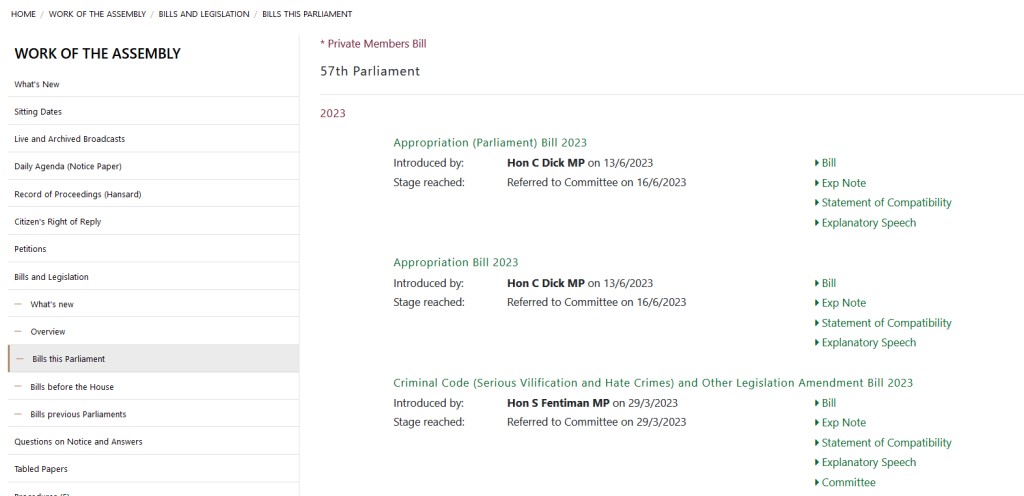30 Parliamentary Documents
Several important documents are produced during the law-making process including the Bill, the explanatory note or memorandum, and the explanatory or second reading speech.
Bills
Some of the most significant documents produced by Parliament are Bills. A Bill is a proposed Act and the principal means by which government policy becomes law. Nowadays, the majority of Bills are drafted by the Office of the Parliamentary Counsel and then debated and considered in detail in Parliament before they are passed and become law.
Bills have clauses instead of sections or provisions. They are usually introduced by the government of the day, however, non-government Bills may be introduced in the form of Private Members’ Bills. According to House of Representatives Practice, Private Members’ Bills often “relate to matters of social and / or moral significance, such as euthenasia and superannuation entitlements of same-sex couples”.
Extrinsic material
Interpretive materials such as explanatory memoranda or notes and parliamentary speeches are useful when researching the intent of the legislation and fleshing out the purpose and finer details of statutes. These materials are referred to as extrinsic material because although they are aids in statutory interpretation, they are not part of the Act.
Explanatory note or memorandum
The explanatory note or memorandum describes the purpose of the Bill and provides explanation of each clause in plain English. These memoranda or notes can be useful in interpreting legislation. They may also be used by courts when considering legislation. The Queensland Parliament refers to these documents as explanatory notes, however, most common law jurisdictions use the term explanatory memoranda.
See Queensland Department of the Premier and Cabinet Guidelines for the preparation of explanatory notes.
Historical explanatory memoranda
Not all Bills will have an associated explanatory statement (particularly older Bills). For more information see Was there an EM?: Explanatory Memoranda and Explanatory Statements in the Commonwealth Parliament or Appendix Two: Explanatory Memoranda in the states and territories.
Parliamentary speeches
A Bill will generally be the subject of several parliamentary speeches, the most significant of which is the explanatory or second reading speech given by the Minister in charge of the Bill. In Queensland, the explanatory speech takes place at the first reading of the Bill. In most other jurisdictions this speech is referred to as a second reading speech because it occurs on the second reading of the Bill.
In this speech, the Minister outlines the policy behind the Bill and what it seeks to achieve. These speeches can help you understand why a Bill has been introduced.
Accessing parliamentary documents
Most common law jurisdictions have a parliamentary website that you can use to access a full range of parliamentary documents. The Queensland Parliament website conveniently allows you to access a current Bill, explanatory speech and explanatory note in the same place. It also indicates the process of the Bill through Parliament.

For more guidance on finding parliamentary documents read our guide on parliamentary and government information.

